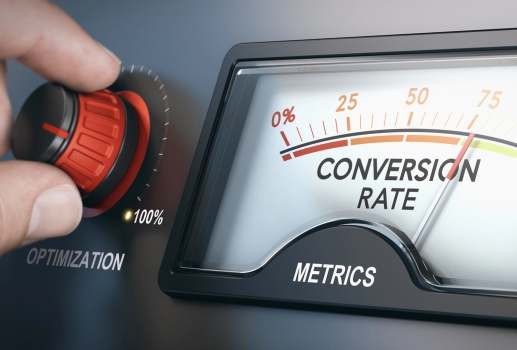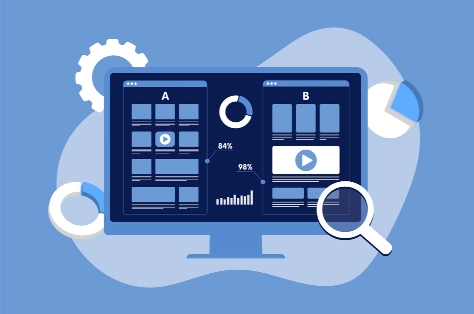EXPERT CONVERSION RATE OPTIMIZATION SERVICES AT SACHS MARKETING GROUP
Conversion Rate Optimization (CRO) is the key to unlocking your website’s full potential. By analyzing user behavior and implementing data-driven conversion optimization strategies, a conversion optimization agency ensures that your site converts visitors into loyal customers. With expert conversion rate optimization services, you can enhance user experience, boost engagement, and achieve measurable results tailored to your business goals.


WHAT IS CONVERSION RATE OPTIMIZATION (CRO)?
Conversion Rate Optimization (CRO) is the practice of enhancing your website to achieve a higher percentage of conversions from the same amount of traffic.
This involves a conversion optimization process using tools like heat maps, A/B testing, and user surveys to identify friction points and implement targeted changes.
CRO encompasses everything from layout adjustments to call-to-action optimization, ensuring your website meets both user expectations and business objectives.
CONVERSION RATE OPTIMIZATION AGENCY VS. CONVERSION RATE OPTIMIZATION FIRM
A Conversion Rate Optimization Agency typically offers a comprehensive range of digital marketing services, with CRO being one of their specialties.
A CRO agency often combines CRO with services like Search Engine Optimization (SEO) and PPC for a holistic approach to boosting online performance.
A Conversion Rate Optimization Firm, on the other hand, is often more specialized, focusing exclusively on CRO strategies and execution.
While both provide valuable services, the right choice depends on your business goals and whether you need a focused or integrated digital marketing approach.

FACTORS IMPACTING CONVERSION RATE OPTIMIZATION SUCCESS
Successful conversion rate optimization (CRO) depends on several key factors that influence how website visitors (users) interact with your website.
These elements ensure a smooth, engaging, and trustworthy experience that encourages visitors to take desired actions. By focusing on these critical aspects, you can maximize the effectiveness of your CRO efforts.
CRO agencies, like Sachs Marketing Group can help businesses focus on these critical aspects to maximize CRO effectiveness.
KEY PERFORMANCE FACTORS FOR CRO

USER EXPERIENCE AND SITE NAVIGATION
Intuitive design and seamless navigation guide users to the information they need, reducing frustration and improving engagement.

PAGE LOAD SPEED AND RESPONSIVENESS
Fast-loading, mobile-friendly pages keep visitors on your site longer, preventing drop-offs caused by delays or poor responsiveness.
CLEAR, COMPELLING CALLS-TO-ACTION
Well-placed and visually appealing CTAs encourage users to take the next step, whether it is making a purchase, signing up, or contacting your team.

TRUST SIGNALS AND SOCIAL PROOF
Elements like customer reviews, testimonials, and security badges build confidence in your brand, encouraging visitors to convert.

STRATEGIC USE OF ANALYTICS AND A/B TESTING
Data-driven decisions and continuous testing help identify and implement changes that resonate with your audience, driving consistent improvements.
CONVERSION RATE OPTIMIZATION PROCESS
There are several types of PPC ads, each suited to different marketing goals and platforms:
STEP 1:
WEBSITE ANALYSIS AND GOAL SETTING
Our conversion rate optimization agency begins by conducting a thorough website analysis to identify areas of improvement and set clear goals for the optimization process.
This involves reviewing website analytics, user feedback, and industry benchmarks to determine the current conversion rate and identify opportunities for growth.
Our team of experts will work closely with you to establish specific, measurable, achievable, relevant, and time-bound (SMART) goals for the optimization process.
STEP 2:
HYPOTHESIS DEVELOPMENT AND TESTING
Our team will develop hypotheses for improving the conversion rate based on the insights gathered during the website analysis.
To determine their validity, these hypotheses will be tested through A/B testing, multivariate testing, and other experimentation methods.
Our conversion optimization services include the design and implementation of tests and the analysis of results to inform future optimization efforts.
STEP 3:
DATA ANALYSIS AND INSIGHTS
Our team will analyze the data collected during the testing phase to identify trends, patterns, and insights that can inform future optimization efforts.
This involves using data analysis tools and techniques to segment users, track behavior, and measure the impact of different variables on the conversion rate.
Our conversion rate optimization agency will provide actionable insights and recommendations for improving the conversion rate.
STEP 4:
IMPLEMENTATION AND ITERATION
Shown on websites and blogs, these ads are effective for reaching specific audiences and demographics.Based on the insights gathered during the data analysis phase, our team will implement changes to the website to improve the conversion rate.
This may involve updating the website design, content, and user experience to align with user behavior and preferences. Our conversion optimization services include ongoing iteration and refinement to ensure that the website continues to meet the evolving needs of users and drive business growth.
Following this website conversion rate optimization process, our agency can help you boost conversions, increase conversions, and drive business growth through data-driven optimization.
Our team of experts has extensive experience in conversion rate optimization, user research, and data analysis, and we are committed to deli2vering results-driven solutions that meet your unique needs and goals.
HOW THE BEST CONVERSION RATE OPTIMIZATION COMPANIES LIKE SACHS MARKETING GROUP GET RESULTS
The best conversion rate optimization companies use proven strategies to turn website traffic into meaningful conversions.
Companies like Sachs Marketing Group implement targeted changes that yield measurable results by leveraging data-driven techniques and focusing on user behavior.
Below are the key tactics that drive CRO success:
PROVEN TACTICS FOR EFFECTIVE CRO

COMPREHENSIVE WEBSITE AUDITS
A thorough website analysis identifies improvement areas, from page design to user flow, ensuring no conversion opportunities are overlooked.

HEAT MAP ANALYSIS
Heat maps reveal where users spend their time, helping prioritize key areas for improvement and ensuring the most critical content grabs attention.

A/B TESTING AND MULTIVARIATE TESTING
By testing different variations of web elements like headlines, CTAs, and layouts, businesses can confidently identify the highest-performing combinations and implement them.
USABILITY TESTING AND LIVE FEEDBACK
Observing real users interact with your website uncovers hidden barriers to conversion and provides actionable insights to streamline the user experience.

LEVERAGING TRUST SIGNALS AND SOCIAL PROOF
Incorporating customer reviews, testimonials, and security badges helps build trust and encourages visitors to take the desired actions.
By implementing these tactics, conversion rate optimization companies deliver tailored solutions that align with your business objectives and audience needs.
WHY CHOOSE A CONVERSION RATE OPTIMIZATION AGENCY LIKE SACHS MARKETING GROUP?
Conversion rate optimization (CRO) services can significantly enhance your business's bottom line.
By improving the efficiency of your website, CRO ensures you make the most of your existing traffic. This means increased conversions, reduced customer acquisition costs, and long-term growth.
Partnering with a conversion rate optimization agency gives you access to specialized expertise and tools, ensuring your investment delivers measurable ROI.
BENEFITS OF CONVERSION RATE OPTIMIZATION
INCREASED ROI
PPC ads appear at the top of search engine results, giving your business prime real estate and making it easy for potential customers to find you.
IMPROVED USER EXPERIENCE
Unlike any other digital marketing strategy, PPC delivers instant traffic as soon as your ads go live, quickly boosting website visitors.
BOOSTED REVENUE AND CUSTOMER ENGAGEMENT
Targeted ad campaigns allow you to attract high-quality leads, improving the chances of converting visitors into customers.
HARNESS THE POWER OF DATA WITH THE BEST CONVERSION RATE OPTIMIZATION COMPANIES
Data is the foundation of effective conversion rate optimization (CRO).
By leveraging analytics, businesses can identify what works and what does not, ensuring every change is based on evidence rather than guesswork.
The best conversion rate optimization companies rely on advanced tools and methodologies to unlock the insights needed to drive measurable improvements.
Additionally, integrating search engine optimization with CRO enhances website visibility and drives engagement, creating a comprehensive digital marketing strategy.
BENEFITS OF HEAT MAPS AND A/B TESTING FOR CONVERSION RATE OPTIMIZATION CRO
Heat Maps: Visualizing User Behavior
Heat maps provide a detailed view of how users interact with your website, highlighting areas where they click, scroll, or linger.
This visual data helps identify underperforming sections and guides adjustments to optimize user engagement and conversions.


A/B Testing: Data-Driven Decision Making
A/B testing allows businesses to compare two versions of a webpage or element to see which performs better.
You can make informed decisions that yield the best results without relying on assumptions by testing one change at a time, such as a headline or call-to-action placement.
Harnessing tools like heat maps and A/B testing ensures your CRO efforts are precise and impactful, driving consistent growth and improved user experiences.
Ready to see results?
Partner with Sachs Marketing Group for proven CRO strategies that deliver results.
Contact us today to start transforming your ad results and driving growth for your business.
WHY CHOOSE SACHS MARKETING GROUP AS YOUR PPC AGENCY?
Sachs Marketing Group is your go-to PPC agency, known for delivering exceptional results and helping businesses of all sizes achieve their digital marketing goals.
Our successful management and optimization of a Google Ads account, including strategies like Single Keyword Ad Group (SKAG) structure, result in significant performance improvements and increased return on ad spend (ROAS).
Our digital marketing knowledge, dedication to client success, and data-driven approach make us the perfect partner for your PPC campaigns.
A WELL-MANAGED PPC CAMPAIGN BRINGS SEVERAL KEY ADVANTAGES:

TAILORED STRATEGIES FOR YOUR INDUSTRY
We understand that every industry has its own set of challenges and opportunities. Our team crafts personalized CRO strategies designed to resonate with your target audience, ensuring that your website aligns with your business goals and customer expectations.

DEDICATED TEAM OF CRO EXPERTS
Our team of experienced professionals is passionate about helping your business succeed. From data analysis to implementation, we are with you every step of the way, ensuring a seamless process and measurable outcomes.

PROVEN TRACK RECORD OF SUCCESS
We have helped businesses across industries achieve significant improvements in conversion rates. Our case studies and client testimonials speak to the consistent results we deliver, making us one of the best conversion rate optimization companies in the industry.

ADVANCED TOOLS AND METHODOLOGIES
Using cutting-edge tools like heat maps, A/B testing platforms, and advanced analytics, we provide actionable insights that drive success. Our data-driven approach ensures that every decision is backed by evidence, maximizing your ROI.
Partner with Sachs Marketing Group today to transform your website into a powerful tool for driving growth and achieving your business objectives.
HOW CONVERSION RATE OPTIMIZATION AGENCIES CAN BOOST LEAD GENERATION
Conversion rate optimization (CRO) transforms your website from a static platform into a powerful lead-generation tool. By analyzing user behavior and implementing strategic changes, CRO ensures that traffic is effectively converted into high-quality leads.
Partnering with expert conversion rate optimization agencies ensures your website maximizes every visitor's potential.
BENEFITS OF CRO FOR LEAD GENERATION
HIGHER CONVERSION RATES
CRO focuses on optimizing your website to turn more visitors into leads. This means you achieve more results without needing to drive additional traffic.
ENHANCED USER ENGAGEMENT
CRO keeps users engaged longer by improving website navigation, design, and content. The better their experience, the more likely they are to complete desired actions, such as filling out a form or requesting a quote.
OPTIMIZED CALLS-TO-ACTION
Clear and compelling calls-to-action (CTAs) guide users through the lead generation process. CRO ensures that CTAs are strategically placed and designed to inspire action, increasing the number of leads you capture.
Investing in CRO improves your website’s performance and ensures a steady stream of qualified leads, fueling your business’s growth.
YOUR TRUSTED PARTNER IN CONVERSION RATE OPTIMIZATION
Choosing the right partner for conversion rate optimization (CRO) can make all the difference in your business’s success. At Sachs Marketing Group, we combine expertise, innovation, and personalized service to help your website achieve its full potential.

EXPERIENCED CRO SPECIALISTS
Our team of seasoned experts brings years of experience to the table. From identifying conversion barriers to implementing advanced strategies, we know what it takes to deliver measurable results tailored to your unique business needs.

DATA-DRIVEN APPROACH
At Sachs Marketing Group, every decision we make is backed by data. Using tools like analytics, heat maps, and A/B testing, we ensure that every change is purposeful and designed to maximize your ROI.

UNPARALLELED CUSTOMER SUPPORT
We believe in building long-term relationships with our clients. Our dedicated support team is always available to answer questions, provide updates, and ensure your CRO strategy runs smoothly from start to finish.
With Sachs Marketing Group as your CRO partner, you gain more than just a service provider—you gain a trusted ally dedicated to your success.
"*" indicates required fields



